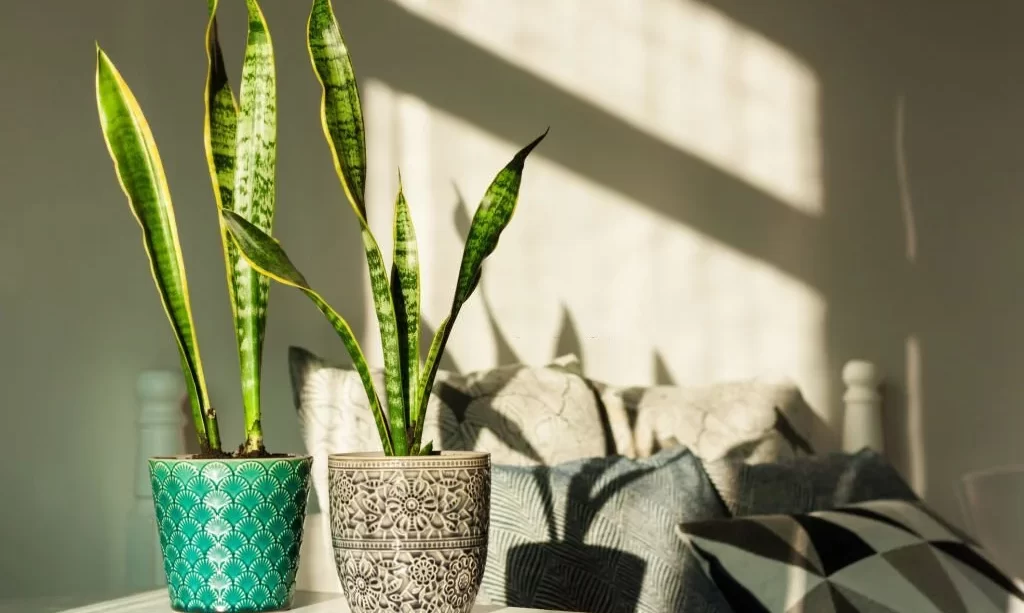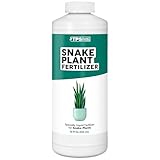Snake plants, with their striking vertical leaves and air-purifying abilities, have earned their place as a favorite among indoor plant enthusiasts. Yet, the question of how much sunlight a snake plant needs often arises, especially for those new to plant care. In this guide, we will explore the unique light requirements of snake plants and provide insights on whether they truly need sunlight to thrive. Whether you’re a seasoned plant lover or just starting your indoor gardening journey, understanding the relationship between snake plants and sunlight is vital for nurturing these resilient green companions.
- Tailored Nutrient Blend: Our indoor houseplant fertilizer is formulated with a precisely balanced blend of nutrients, ensuring your plants receive the specific nourishment they need for robust growth and vibrant foliage.
- Optimal Absorption: The unique liquid formulation is designed for efficient nutrient absorption, delivering essential elements directly to the roots and leaves, resulting in quicker and more noticeable plant health improvements.
- Indoor Environment Focus: Developed with indoor plants in mind, our fertilizer takes into account the specific conditions of indoor settings, providing nutrients that cater to the controlled environment of your home.
- Enhanced Growth Patterns: Our fertilizer encourages and supports growth patterns that are well-suited to indoor spaces, helping your plants thrive without excessive stretching or sprawling.
- Mess-Free Application: Applying our specially crafted fertilizer is simple and mess-free, with easy-to-follow instructions. No more worrying about soil spills or residue on your indoor surfaces.
Natural Habitat of Snake Plants
Snake plants are indigenous to West Africa. They are primarily found in countries such as Nigeria, Ghana, and the Congo. These regions are known for their tropical and subtropical climates, characterized by distinct wet and dry seasons. Snake plants have adapted to thrive in these challenging conditions.
Habitat Characteristics:
- Savannas and Grasslands: Snake plants often grow in savannas and grasslands, where they are exposed to plenty of sunlight. They are well-suited to these open habitats, where they can receive ample light without being shaded by taller vegetation.
- Sandy and Well-Drained Soils: The native soil of snake plants is typically sandy and well-draining. This soil type allows excess water to flow away from the roots, preventing waterlogging, which is crucial for their survival.
- Diverse Species: Snake plants are a diverse group of species within the Sansevieria genus. They can be found in various forms, including those with tall, upright leaves and others with rosettes of shorter leaves. This diversity reflects their adaptability to different microclimates within their native regions.
- Seasonal Climate: Snake plants have evolved to endure alternating wet and dry seasons. During the wet season, they experience regular rainfall, while the dry season brings periods of drought. Their ability to withstand extended periods without water storage in their leaves is a survival advantage in these conditions.
Adaptations for Survival:
Snake plants have several remarkable adaptations that enable them to thrive in their natural habitat:
- Drought Resistance: Their thick, succulent leaves store water, allowing them to survive extended periods of drought. This adaptation is a vital tool for their survival during the dry season.
- Low Light Tolerance: In their native habitat, snake plants often grow under the canopy of taller grasses and plants, which means they are adapted to tolerate low to moderate light conditions. This is one reason why they make excellent indoor plants in homes with varying light levels.
- Minimal Maintenance: Snake plants have evolved to require minimal maintenance, making them a hardy and low-maintenance houseplant option.
Low Light Tolerance
One of the standout features of snake plants is their remarkable tolerance for low light conditions. These plants have adapted to thrive in environments with minimal natural light, making them well-suited for indoor spaces with limited sunlight. Snake plants are often celebrated as low-light champions, as they can endure and even thrive in areas where many other plants would struggle to survive.
- SPECIFICALLY FORMULATED FOR SNAKE PLANTS – A premium blend of all natural peat moss, perlite, lime, and earthworm castings formulated to provide the most optimal growth environment for Snake Plants of all variety. This blend promotes a faster quality plant growth for your snake plants.
- GROW HEALTHY AND VIBRANT SNAKE PLANTS – Our soil blend provides exceptional drainage properties that prevents water logged soil and root problems. Store bought soils may leave your snake plant with droopy and mushy leaves. Our aerated and fast draining blend will allow your snake plant to thrive and grow lush and vibrant.
- READY TO USE PRE-MIXED BLEND: Simplify your gardening hobby with our pre-mixed soil blends for a hassle free potting and replanting experience. Simply transplant your snake plants into their container and add our soil mix.
- RESEALABLE BAG: Packaged in a 8×10 Inch 2 Quart Sized resealable bag. The perfect amount of soil for planting or repotting 1-2 small to medium sized plants.
Ideal Light Conditions
While snake plants are renowned for their resilience in low light, they do have preferences when it comes to sunlight. To promote optimal growth and appearance, snake plants benefit from specific light conditions.
The ideal light conditions for snake plants fall within the range of indirect to moderate light. Here’s what you need to know:
- Indirect Light: Snake plants thrive in bright, indirect light. Place them near a window where they can receive filtered sunlight or indirect light for several hours a day. This mimics their natural habitat, where they grow beneath taller vegetation.
- Avoid Direct Sunlight: While snake plants can tolerate low light, they are sensitive to direct sunlight. Prolonged exposure to harsh, direct sunlight can lead to leaf damage, such as sunburn or scorching. Therefore, it’s best to shield them from direct sun, especially during the intense midday hours.
- Low Light Conditions: Snake plants can adapt to low light conditions but may grow more slowly in such settings. If you have limited natural light in your space, choose snake plant varieties known for their low light tolerance, and consider rotating the pot occasionally to ensure even growth.
- Moderate Light: If possible, provide snake plants with moderate, indirect light. This encourages more robust growth and can help maintain the plant’s vibrant appearance.
Remember that snake plants are incredibly adaptable, making them suitable for a variety of lighting situations. However, their growth rate and overall health will be influenced by the amount and quality of light they receive. Observing your snake plant’s response to its specific location will help you find the perfect balance to ensure it thrives in your home or office environment.
Signs of Insufficient Light
If your snake plant is not receiving enough light, it may exhibit several telltale signs:
- Stunted Growth: In low light conditions, snake plants may grow more slowly or remain smaller than they would in ideal lighting. Their leaves may also be narrower and less robust.
- Leggy Appearance: Insufficient light can cause snake plants to become “leggy,” with elongated stems and leaves that appear stretched out as the plant reaches for more light.
- Fading Colors: The vibrant green color of snake plant leaves may start to fade in low light. The leaves can become paler or take on a yellowish hue.
- Reduced Air Purification: Snake plants are known for their air-purifying properties, but in low light, their ability to cleanse the air may be diminished.
- Leaf Drooping: Inadequate light can lead to leaves that appear floppy or droopy rather than standing upright.
- Sparse Growth: Snake plants grown in low light may produce fewer new leaves and have a more sparse and less lush appearance.
While snake plants can tolerate low light, it’s essential to provide them with as much indirect or moderate light as possible to maintain their health and appearance. If you notice these signs of insufficient light, consider moving your snake plant to a brighter location or providing supplemental artificial lighting to help it thrive.
Adjusting Light for Different Varieties
Snake plants come in various species and varieties, each with its own preferences when it comes to light conditions. To ensure that different snake plant varieties thrive, it’s essential to adjust their light exposure accordingly:
- Sansevieria trifasciata (Common Snake Plant): The most well-known snake plant variety, Sansevieria trifasciata, is highly adaptable to a wide range of light conditions. It can thrive in low to moderate indirect light, making it an excellent choice for dimly lit spaces. However, it also does well in brighter settings.
- Sansevieria cylindrica (Cylindrical Snake Plant): This variety features tall, cylindrical leaves. It prefers bright, indirect light but can adapt to lower light conditions. For the best growth and appearance, provide it with moderate, filtered light.
- Sansevieria moonshine: With its striking silvery-blue leaves, Sansevieria moonshine thrives in moderate, indirect light. Avoid exposing it to direct sunlight, as this can lead to leaf damage.
- Sansevieria zeylanica (Mother-in-Law’s Tongue): This variety is known for its long, sword-shaped leaves with distinctive dark green bands. It can adapt to low light but will grow more vigorously and maintain its appearance better in moderate, indirect light.
- Sansevieria boncellensis (Boncel Snake Plant): This compact snake plant variety features short, stout leaves with unique patterns. It does well in low to moderate indirect light and should be shielded from direct sun exposure.
- Sansevieria hahnii (Bird’s Nest Snake Plant): This variety forms rosette-shaped clusters of leaves. It prefers moderate, indirect light and can tolerate lower light conditions. Keep it out of direct sunlight to prevent leaf scorching.
When growing different snake plant varieties, take note of their individual light requirements and adjust their placement accordingly. Consider the natural habitat of each variety to determine the most suitable light conditions for optimal growth and appearance. Remember that snake plants are adaptable, so some flexibility in lighting can be accommodated, but providing the right light will ensure they thrive and retain their unique characteristics.
Overcoming Low Light Challenges
Growing snake plants in low light conditions can present challenges, but with the right care and strategies, you can help them thrive even in less-than-ideal lighting. Here are some tips for overcoming the challenges of low light:
- Choose Low-Light Tolerant Varieties: Opt for snake plant varieties known for their low light tolerance, such as Sansevieria trifasciata (Common Snake Plant) or Sansevieria cylindrica (Cylindrical Snake Plant). These varieties are more likely to adapt to reduced light levels.
- Supplement with Artificial Lighting: Consider using artificial grow lights to provide the necessary light for your snake plants. LED or fluorescent lights designed for plant growth can be placed above or near the plants to supplement natural light.
- Rotate Your Plants: Periodically rotate your snake plants to ensure that all sides receive some light. This prevents uneven growth and encourages balanced development.
- Keep Windows Clean: If your snake plants are near windows, keep the glass clean to maximize the amount of available natural light.
- Avoid Overwatering: In low light conditions, snake plants may not require as much water as they would in brighter settings. Be cautious not to overwater, as this can lead to root rot.
- Prune Leggy Growth: If your snake plants become leggy (with elongated stems and sparse leaves), you can prune them back to encourage more compact growth.
- Patience and Observation: Understand that snake plants may grow more slowly in low light, and their appearance may differ from those in brighter conditions. Exercise patience and regularly observe your plants to ensure they adapt successfully.
By applying these strategies and being attentive to your snake plants’ specific needs, you can help them thrive even when natural light is limited. With proper care, your low-light-loving snake plants can remain healthy, attractive, and an excellent addition to your indoor space.
Considerations for Outdoor Growth
While snake plants are often grown as indoor houseplants, some snake plant varieties can also thrive outdoors in suitable climates. Here are considerations to keep in mind if you plan to grow snake plants outdoors:
- Climate Compatibility: Ensure that your local climate is conducive to outdoor snake plant growth. Snake plants are generally best suited for USDA plant hardiness zones 9 to 11, where temperatures remain relatively mild year-round.
- Light Requirements: Even when grown outdoors, snake plants prefer bright, indirect light or partial shade. Avoid exposing them to direct, intense sunlight, which can cause leaf damage.
- Well-Draining Soil: Plant snake plants in well-draining soil to prevent waterlogged roots, which can lead to rot. Sandy or loamy soil types with good drainage are ideal.
- Watering: Outdoor snake plants typically require less frequent watering than indoor ones. Allow the soil to dry out between waterings, and adjust the frequency based on local rainfall and weather conditions.
- Protection from Extreme Conditions: While snake plants are hardy, they can be vulnerable to extreme cold or prolonged frost. In colder climates, consider planting them in containers that can be brought indoors during winter or provide protective coverings during freezing temperatures.
- Pests and Diseases: Regularly inspect your outdoor snake plants for pests and signs of diseases. Outdoor environments can introduce new challenges, so vigilance is crucial.
- Size and Spacing: Consider the growth habits and potential size of the snake plant variety you’re planting. Space them accordingly to allow for proper air circulation and prevent overcrowding.
- Mulching: Applying a layer of mulch around the base of your outdoor snake plants can help regulate soil moisture and protect the roots from temperature extremes.
- Seasonal Adjustments: Be prepared to adjust your care routine with changing seasons. In colder months, reduce watering and protect the plants from frost, while in warmer months, monitor their water needs and provide adequate shade during hot afternoons.
- Local Regulations: Check with local regulations and guidelines regarding outdoor planting and any potential invasive species concerns. In some regions, certain snake plant varieties may be classified as invasive.
Growing snake plants outdoors can be a rewarding experience if you live in a suitable climate. With attention to these considerations, you can create an outdoor environment where these hardy and adaptable plants can thrive and enhance your outdoor landscape.
Conclusion
In conclusion, the question of whether a snake plant needs sunlight has been thoroughly explored, shedding light on the unique characteristics of these resilient indoor companions. Snake plants, with their remarkable tolerance for low light, are well-suited for various indoor environments. While they can survive in low light conditions, providing them with the right amount of sunlight is crucial for their optimal growth and appearance.
Understanding the natural habitat of snake plants, their low light tolerance, and ideal light conditions equips you with the knowledge needed to nurture these green wonders successfully. Recognizing the signs of insufficient light and adjusting lighting for different snake plant varieties allows you to cater to their specific needs.
For those facing low light challenges, creative solutions can help your snake plant thrive, ensuring it remains a vibrant addition to your indoor space. Additionally, for outdoor enthusiasts, considering the unique lighting requirements when transitioning snake plants outdoors is essential.
In the end, the balance between snake plants and sunlight is an artful dance, with the right amount of light allowing these plants to purify the air and enhance your living space. Armed with this knowledge, you can create an environment where your snake plant not only survives but thrives, showcasing its unique beauty and air-purifying qualities.







